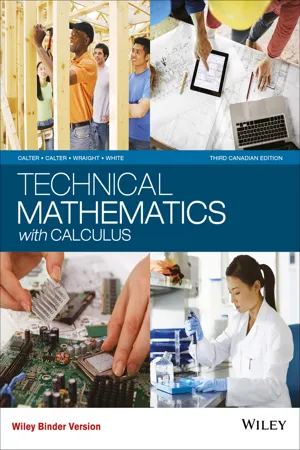Mathematics
Application of Derivatives
The application of derivatives involves using the concept of derivatives from calculus to solve real-world problems. It includes finding maximum and minimum values, determining rates of change, and analyzing the behavior of functions. This application is widely used in various fields such as physics, economics, engineering, and biology to model and understand the behavior of systems and processes.
Written by Perlego with AI-assistance
Related key terms
1 of 5
5 Key excerpts on "Application of Derivatives"
- eBook - PDF
- Michael A. Calter, Paul A. Calter, Paul Wraight, Sarah White(Authors)
- 2016(Publication Date)
- Wiley(Publisher)
29 ◆◆◆ OBJECTIVES ◆◆◆◆◆◆◆◆◆◆◆◆◆◆◆◆◆◆◆◆◆◆◆◆◆◆◆◆◆◆◆◆◆◆◆◆◆◆◆◆◆◆◆◆◆◆◆◆◆◆◆◆◆◆◆◆◆◆◆ When you have completed this chapter, you should be able to: • Calculate rates of change. • Calculate the motion of a point. • Solve problems using related rates. • Find optimal solutions using derivatives. What is this stuff good for? This chapter gives the main answer to that question, at least for the derivative. You saw in Chapter 28 how applications using the derivative were helpful in solving math- ematical and geometric problems. In this chapter, we will spread out more and look at other applications. These applications have to do with rates of change. This is where calculus shines at problem solving. You saw that the derivative represents the slope of a line—the amount y changes with respect to a change in x. If the x axis becomes a time axis, anything that changes over time, such as velocity or acceleration, can become a derivative calculation. Calculus is the best way of describing anything in motion. The inspiration for the development of calculus came from Newton’s study of gravity. Gravity follows an inverse square law and plots not as a straight line but as a curved line. The curved line has a slope that is changing. Algebra is not very good at describing rates of change, so the need to describe rates of change led Newton to develop calculus. For electrical applications, we use the rate of change of charge to find current, the rate of change of current to find the voltage across an inductor, and the rate of change of voltage to find the current in a capacitor. We will then go on to use the fact that the derivative is zero at a maximum or minimum point to find maximum and minimum values of a varying quantity. Applied Applications of the Derivative 29–1 Rate of Change Rate of Change Given by the Derivative We already established in Chapter 27 that the first derivative of a function gives the rate of change of that function. - eBook - PDF
- Charles R. MacCluer(Author)
- 2020(Publication Date)
- Princeton University Press(Publisher)
6 Applications of the Derivative We will now survey the many uses of the derivative in geometry, sensitivity analysis, approximation, linearization, optimization, rates of change, mechanics, orbital motion, and economics. Herein are many valuable tools and techniques to be mastered. 6.1 Tangents Suppose f : [a, b] — > R and a < XQ < b. What does it mean that the graph of y = f{x) has a tangent line y — mx + b at p = (XQ, f (*o))? One may propose definitions such as the tangent line is the line that meets the graph at p and only at p. But the example f(x) = |x|at*o = 0 busts this first proposal—many lines meet the the graph of f only once at (0,0). We are attempting to capture and generalize the familiar notion of a tangent to a circle. That suggests finding the best fitting circle to the graph of y = f(x) at p, then using the tangent to this osculating circle as the tangent to the graph. Or, appealing to modern experience, use the zoom feature of a graphing calculator to repeatedly zoom in toward the point p. (Try this with say f(x) = x 2 at XQ = 1.) Notice how the apparent curvature of the graph of f flattens until the graph becomes a straight line—this is our tangent line. But what has happened in this zooming process? We have been examining the portion of the curve y = f(x) with x restricted to ever-smaller neighborhoods (*o — &,XQ + 8), where we can no longer distinguish the curve from the secant lines of figure 6.1, whose slopes are given by difference quotients F(x) = fix) -f(x 0 ) X-XQ (6.1) This allows us to leap to the following. Definition A. Suppose f is differentiable at x = XQ. Then the line tangent to the graph ofy = f(x) at p = (XQ, f(xo)) is y = mx+b, where the slope m 6.1 Tangents 61 Figure 6.1 The secant lines from p. As we zoom in, the graph becomes indistinguishable from its tangent line. is the derivative of f at XQ and where the y-intercept b is chosen so that the line passes through p: f'(x o )(x-x o ). - eBook - PDF
- Geoffrey Berresford, Andrew Rockett(Authors)
- 2015(Publication Date)
- Cengage Learning EMEA(Publisher)
Further Applications of Derivatives 3 ©pryzmat/Shutterstock.com What You’ll Explore A graph is a picture of a function, showing how steeply the function is rising or falling along with any high or low points. Such information is very useful for inter-preting a company’s profit function, a medicine’s dose-response function, or any of the stimulus-response functions graphed on the next page. Finding only the highest and lowest values of the function is called optimization , allowing us to maximize revenue, minimize cost, and to find the optimal point for any quantity that can be expressed as a function. 3.1 Graphing Using the First Derivative 3.2 Graphing Using the First and Second Derivatives 3.3 Optimization 3.4 Further Applications of Optimization 3.5 Optimizing Lot Size and Harvest Size 3.6 Implicit Differentiation and Related Rates 3.7 Differentials, Approximations, and Marginal Analysis Copyright 2016 Cengage Learning. All Rights Reserved. May not be copied, scanned, or duplicated, in whole or in part. Due to electronic rights, some third party content may be suppressed from the eBook and/or eChapter(s). Editorial review has deemed that any suppressed content does not materially affect the overall learning experience. Cengage Learning reserves the right to remove additional content at any time if subsequent rights restrictions require it. APPLICATION PREVIEW Stevens’ Law of Psychophysics How accurately can you judge how heavy something is? If you give someone two weights, with one twice as heavy as the other, most people will judge the heavier weight as being less than twice as heavy. This is one of the oldest problems in experimental psychology—how sensation (perceived weight) varies with stimu-lus (actual weight). Similar experiments can be performed for perceived bright-ness of a light compared with actual brightness, perceived effort compared with actual work, and so on. - Ron Larson(Author)
- 2016(Publication Date)
- Cengage Learning EMEA(Publisher)
All Rights Reserved. May not be copied, scanned, or duplicated, in whole or in part. WCN 02-300 200 Chapter 3 Applications of the Derivative As applications go, the examples described in this section are fairly simple, and yet the resulting primary equations are quite complicated. Real-life applications often involve equations that are at least as complex as the ones in the examples. Remember that one of the main goals of this course is to enable you to use the power of calculus to analyze equations that at first glance seem formidable. Also remember that once you have found the primary equation, you can use the graph of the equation to help solve the problem. For instance, the graphs of the primary equations in Examples 1 through 3 are shown in Figure 3.36. 10 8 6 4 2 12 120 100 80 60 40 20 (6, 108) x x 3 4 V V = 27 x -x -3 -2 -1 2 3 1 6 5 4 3 1 ( -, ) d 3 2 7 2 d = x 4 -3 x 2 + 4 ( , ) 3 2 7 2 Example 1 Example 2 (18, 384) x A = 4 x + 240 + 1296 x A 5 10 15 20 25 30 100 200 300 400 500 600 700 800 Example 3 FIGURE 3.36 S U MMARIZE (Section 3.4) 1. State what is meant by the primary equation of an optimization problem (page 196) . For examples of primary equations in optimization problems, see Examples 1, 2, and 3. 2. State what is meant by the feasible domain of a function (page 196) . For examples of feasible domains, see Examples 1, 2, and 3. 3. State what is meant by the secondary equation of an optimization problem (page 197) . For examples of secondary equations in optimization problems, see Examples 1, 2, and 3. 4. State the guidelines for solving optimization problems (page 197) . For examples of solving optimization problems, see Examples 2 and 3. 5. Describe a real-life example of how solving an optimization problem can be used to determine the dimensions of a page so that the amount of paper used is minimized (page 199, Example 3) . Tom Wang/Shutterstock.com Copyright 2018 Cengage Learning.- eBook - PDF
A Course of Higher Mathematics
Adiwes International Series in Mathematics, Volume 1
- V. I. Smirnov, A. J. Lohwater(Authors)
- 2014(Publication Date)
- Pergamon(Publisher)
CHAPTER II DIFFERENTIATION: THEORY AND APPLICATIONS § 3. Derivatives and differentials of the first order 45. The concept of derivative. We consider a point moving in a straight line. The path s traversed by the point, measured from some definite point of the line, is evidently a function of time t: A corresponding value of s is defined for every definite value of t. If t receives an increment At, the path s -f-As will then correspond to the new instant t + At, where As is the path traversed in the interval At. In the case of uniform motion, the increment of path is proportional to the increment of time, and the ratio As/At repre-sents the constant velocity of the motion. This ratio is in general dependent both on the choice of the instant t and on the increment At, and represents the average velocity of the motion during the interval from t to t + At. This average velocity is the velocity of an imaginary point which moves uniformly and traverses path As in time At. For example, we have in the case of uniformly accelerated motion: s = — gt 2 + v 0 t and As -^-g(t + At)* + v 0 (t + At)--Lgt*-v 0 t -ÂT= : Ät = i * + *o + -2-fl^. The smaller the interval of time t, the more we are justified in taking the motion of the point in question as uniform in this interval, and the limit of the ratio As/At, with At tending to zero, defines the velocity v at the given instant t : T As v = lim — rr · 101
Index pages curate the most relevant extracts from our library of academic textbooks. They’ve been created using an in-house natural language model (NLM), each adding context and meaning to key research topics.




